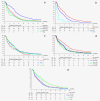Prognostic factors for soft tissue sarcoma patients with lung metastases only who are receiving first-line chemotherapy: An exploratory, retrospective analysis of the European Organization for Research and Treatment of Cancer-Soft Tissue and Bone Sarcoma Group (EORTC-STBSG)
- PMID: 29383713
- PMCID: PMC5947111
- DOI: 10.1002/ijc.31286
Prognostic factors for soft tissue sarcoma patients with lung metastases only who are receiving first-line chemotherapy: An exploratory, retrospective analysis of the European Organization for Research and Treatment of Cancer-Soft Tissue and Bone Sarcoma Group (EORTC-STBSG)
Abstract
The prognosis of adult soft tissue sarcoma (STS) patients with metastases is generally poor. As little is known about the impact of the involvement of different metastatic sites and the extent of pulmonary lesions on the outcome for patients receiving first-line chemotherapy, we aimed to establish prognostic factors for STS patients with lung metastases only. A retrospective, exploratory analysis was performed on 2,913 metastatic STS patients who received first-line chemotherapy. Detailed information from 580 patients who had lung metastases only, was used for prognostic factor analysis. Patients with lung metastases only were more often asymptomatic and had undergone complete primary tumor resection more frequently compared to patients with additional metastases outside the lung or without lung metastases. For extremity STS, the incidence of lung metastases only was much higher compared to non-extremity STS. Lung involvement only was an independent favorable prognostic factor for overall survival (OS) with regard to metastatic site. Within this subgroup, in a multivariate model, other factors associated with improved OS included: good performance status (PS), no progression at primary site, low histological grade, younger age, long interval between initial diagnosis and trial registration, and smaller diameter of the largest lung lesion. This unique analysis on prognostic factors in STS patients with lung metastases confirms well-known patient factors (such as age and PS), and tumor characteristics (including tumor grade, interval between primary diagnosis, and metastases), but also identifies diameter of the largest lung lesion as a new prognostic factor. Knowledge about these factors may support decision-making within multidisciplinary tumor boards.
Keywords: EORTC; lung metastases; prognostic factors; soft tissue sarcoma.
© 2018 The Authors International Journal of Cancer published by John Wiley & Sons Ltd on behalf of UICC.
Figures



References
-
- Ng VY, Scharschmidt TJ, Mayerson JL, et al. Incidence and survival in sarcoma in the United States: a focus on musculoskeletal lesions. Anticancer Res 2013;33:2597–604. - PubMed
-
- Gatta G, Capocaccia R, Trama A, et al. The burden of rare cancers in Europe. Adv Exp Med Biol 2010;686:285–303. - PubMed
-
- Pisters PW, Weiss M, Maki RG. Soft‐Tissue Sarcomas In: Haller DG, Wagman LD, Camphausen C, Hoskins WJ, eds. Cancer management: a multidisciplinary approach medical, surgical, & radiation oncology, 14 edn. New York: UBM Medica LLC, 2011.
-
- Pisters PW, Leung DH, Woodruff J, et al. Analysis of prognostic factors in 1,041 patients with localized soft tissue sarcomas of the extremities. JCO 1996;14:1679–89. - PubMed
-
- Komdeur R, Hoekstra HJ, van den Berg E, et al. Metastasis in soft tissue sarcomas: prognostic criteria and treatment perspectives. Cancer Metastasis Rev 2002;21:167–83. - PubMed
Publication types
MeSH terms
LinkOut - more resources
Full Text Sources
Other Literature Sources
Medical
Research Materials

